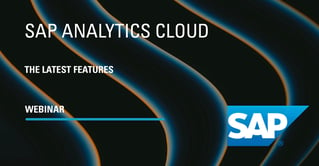Share this
Best practices for implementing SAC
Implementing SAP Analytics Cloud (SAC) can be complex. Where do you start? Which pitfalls should you avoid? Discover the best practices we recently shared in our Round Table session, together with our clients ASML and Asics. How do you ensure a successful and smooth implementation of SAC?

SAP Analytics Cloud (SAC) is a versatile tool using state-of-the-art technology. Not surprisingly, more and more organizations are selecting SAP Analytics Cloud (SAC). Whether you use it for your BI or your (financial) planning, it helps your organization become more data-driven.
In practice, however, we see many organizations struggling with implementing SAC. Often, the complexity is underestimated, as is the business change that is needed. We see that various aspects cause this complexity, such as involving many stakeholders and business processes, creating a clear picture of the information needs, effective master data management, a central location to access the data, and understanding the new features and possibilities of SAC. Reason enough to organize a Round Table to share experiences, best practices, and tips.
Start with a vision of BI and planning
A successful SAC implementation starts with a clear vision of BI and planning. “At Asics, we wanted SAC to support several business processes simultaneously, with Self Service BI at a regional level but supported globally. This aligns with our roadmap for the Asics global strategy. We aim to have one single source of the truth based on one data warehouse for all our locations worldwide,” says Menno Huijgen, Global Director of SAP Finance & Analytics at Asics.
Rob Beeren, IT Group Lead Corporate Analytics at ASML, agrees that having a clear vision is crucial: “At ASML, our goal is an integrated planning landscape. We are moving towards integrated - or connected - planning, with less distinction between financial and operational planning. This requires different functionalities. Also, to optimize collaboration, we want the same information to be available for various users at all times. To do so, we want to provide our users with self-service functionalities and datasets that are secure and trusted.
"Often, we see a lot of inconsistencies in the data and the master data. It's crucial to solve these before you start the implementation to ensure that your user can rely on their reports."
Build a consistent data warehouse
A second key success factor is building a reliable, consistent data warehouse. Menno: “The architecture for the data warehouse should be thought out in detail before the start of the implementation. Otherwise, you might risk losing the buy-in of the business due to delays or dashboards that don’t give the right results.”
Azzeddine Ferchachi, a consultant at Plainwater, agrees: “Often, we see a lot of inconsistencies in the data and the master data. It’s crucial to solve these before you start the implementation to ensure that your users can rely on their reports.” Plainwater and Swap Support are sister organizations that help organizations such as Asics and ASML implement and support their SAC solutions.
A widespread misconception is that SAC is a great tool to structure your data. “We often hear this, but SAP HANA or SAP BW are much better suited to structure data,” explains Azzeddine.
Don’t forget the business
Another takeaway of the Round Table is the importance of recognizing that SAP Analytics Cloud is a relatively new tool. “SAC is certainly innovative, but in our experience, it is mature enough for complex planning models,” says Ruben Rombouts, consultant at Swap Support.
The participants agree that the novelty of the tool requires more change management than the implementation of a traditional tool does, as its many possibilities may be lesser known within your organization. “To understand all the functionalities of SAC, we did a Proof of Concept together with Swap Support. During the POC, we involved the business. Getting the business on board this early helped enormously in adapting the tool,” explains Rob.
At Asics, SAC was selected by Asics Global. Menno: “We involved the business later on – now, the business units are the process owners. They are responsible for the requirements and the creation of the reports.”
“SAP pushes regular releases to you. This is done automatically, but you don’t have to accept these blindly. It’s important to test these releases within your test environment."
Ruben Rombouts
Support for SAC is still needed
A second misconception is that SAC doesn’t need support, as it is a SAAS (Software as a Service) solution. “SAP pushes regular releases to you. This is done automatically, but you don’t have to accept these blindly. It’s important to test these releases within your test environment,” says Ruben. “Also, these releases often have new functionalities and may bring you new possibilities.”
SAC can be seen as a toolbox, giving you many possibilities. However, you do need to adapt these for your organization. Once set up, SAC gives you many Self-Service BI (SSBI) opportunities. However, adapting and maintaining the planning model will always require expert knowledge.
Ensure scarce expert knowledge
Many companies struggle to have the resources needed to implement and support SAC, and all participants agree that focusing on getting expert knowledge is key.
“ASML has ambitious growth targets. Combined with the current labor market, it can be quite challenging to have enough expertise to implement and support SAC,” says Rob. “We’re solving this by using internal and external resources. This combination lets us benefit from the consultants’ experience and in-depth knowledge of the latest technical developments.”
More best practices for your SAC implementation
Would you like to hear more about best practices for your SAC implementation? Please contact Judith Pennings. She is happy to discuss your situation with you.
Watch our webinar
Discover the ins and outs of the Q4 2023 and Q1 2024 releases and get even more out of your SAC application.
Share this
- November 2025 (2)
- April 2025 (2)
- March 2025 (2)
- February 2025 (2)
- December 2024 (1)
- July 2024 (3)
- April 2024 (2)
- March 2024 (1)
- February 2024 (1)
- January 2024 (3)
- December 2023 (1)
- June 2023 (1)
- April 2023 (1)
- March 2023 (1)
- December 2022 (1)
- September 2022 (1)
- August 2022 (2)
- February 2022 (1)
- December 2021 (1)
- May 2021 (15)
- April 2021 (24)
